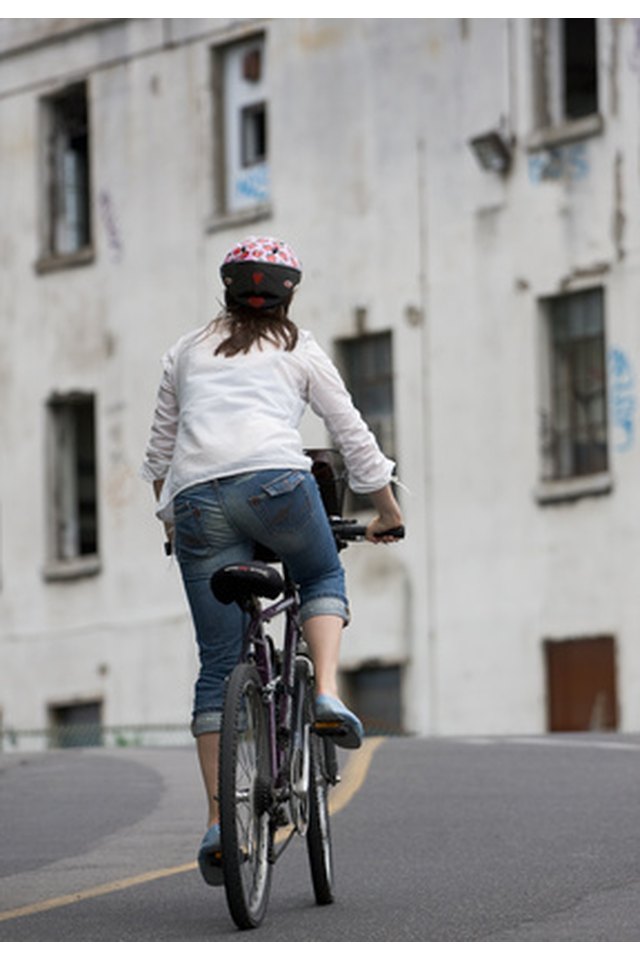How to Use Shimano Gears

The gears on your bicycle allow you to adjust how easily it is to pedal. If you encounter a hill, big or small, shifting to an easier gear will help you climb it. When riding on flat surfaces or at a decline, you can shift into a harder gear to maintain a nice pedaling cadence. Knowing how to use your gears will make your rides more enjoyable and make you a more efficient cyclist. Shimano gears are shifted by either a twist-grip shifter, finger shifter, or the shifters are incorporated into your brake levers.
Locate the front set of gears, the ones nearest the pedals. These are the chainrings and your bike will have one to three of them in increasing sizes. The biggest one will be the hardest gear and the smallest one will be the easiest gear. When you shift with the left-hand shifter, the front derailleur moves the chain over the chainrings. Most rides you might never shift the front gears unless there is a large difference in elevation.
Locate the rear gears, the ones attached to your back wheel. These are called a cassette and the individual gears are called cogs. These work the opposite of the front gears, where the smallest one is the hardest gear and the biggest one is the easiest. When you shift with the right-hand shifter the rear derailleur moves the chain over the cogs. You will shift on the cassette numerous times during a ride.
Determine what type of Shimano shifters you have. Some older mountain bikes and hybrid bikes have grip shifters that are integrated into the handlebar and are twisted to change gears. More modern mountain bikes and hybrids will have indexed thumb shifters mounted on the handlebar that you click with your finger and thumb to change gears. Newer road bikes will have the shifters integrated in with the brake levers.
Shift the rear derailleur by manipulating the right-hand shifter while pedaling. On a twist-shift system grip the handlebar and turn either clockwise to go to a harder gear or counterclockwise to go to an easier gear. On a thumb shifter you will click one lever with your finger to move the gears down and your thumb to move the gears up. With a brake lever system on a road bike, use your fingers to press the lever inward (toward the stem of the handlebar) to go into an easier gear and press either the small lever located on the side of the brake hood or the lever behind the brake lever to move into a harder gear.
Shift the front derailleur by using the left-hand shifters while pedaling. They work opposite to the right-hand shifters. On a twist-shift system grip the handlebar and turn either clockwise to go to an easier gear or counterclockwise to go to a harder gear. On a thumb shifter you will click one lever with your finger to move the gears up and click the other with your thumb to move the gears down. With a brake-lever system on a road bike, use your fingers to press the lever inward (toward the stem of the handlebar) to go into a harder gear and press either the small lever located on the side of the brake hood or the lever behind the brake lever to move into an easier gear.
Tips
Practice using your gears on a flat surface before trying to tackle hills.
Remember to shift before starting up a hill in order to not tire out too quickly. You can shift again as needed.
On road bikes the front gears are often quite different in size, especially if you have three chainrings. You need to push the shifter completely to move the chain into the next gear otherwise the chain might fall off.
Warnings
Avoid shifting to two extremes, such as the smallest chainring and smallest cog. Your chain could fall off.
References
Tips
- Practice using your gears on a flat surface before trying to tackle hills.
- Remember to shift before starting up a hill in order to not tire out too quickly. You can shift again as needed.
- On road bikes the front gears are often quite different in size, especially if you have three chainrings. You need to push the shifter completely to move the chain into the next gear otherwise the chain might fall off.
Warnings
- Avoid shifting to two extremes, such as the smallest chainring and smallest cog. Your chain could fall off.
Writer Bio
Based in Portland, Ore., Tammie Painter has been writing garden, fitness, science and travel articles since 2008. Her articles have appeared in magazines such as "Herb Companion" and "Northwest Travel" and she is the author of six books. Painter earned her Bachelor of Science in biology from Portland State University.
